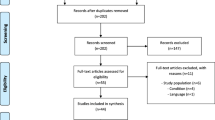Abstract
Introduction and hypothesis
A study was performed to assess the satisfaction rate (SR) after transobturator procedures in pad negative women.
Methods
All patients were asked to complete Urogenital Distress Inventory (UDI) questionnaire. SR after the procedure was estimated by means of VAS scale. Two groups were formed (group 0, 100% SR; group 1, <100% SR) and compared by means of Student t test and Chi-square test. Predictors of SR were tested by linear regression model.
Results
Data was available for 168 women. The mean follow-up was 18.4 weeks, a negative pad test was observed in 153 patients (91.1%). Less than 100% SR was observed in 83 (54.2%) women with negative pad test. SR was significantly predicted by total UDI and irritative UDI score after surgery (p < 0.001), the later bearing also greatest negative impact on QoL (p < 0.001).
Conclusions
Irritative symptoms are the main reason for dissatisfaction of patients with surgical outcome.


Similar content being viewed by others
Abbreviations
- CR:
-
Continence rate
- IIQ:
-
Incontinence Impact Questionnaire
- MUI:
-
Mixed urinary incontinence
- QoL:
-
Quality of life
- SUI:
-
Stress urinary incontinence
- SR:
-
Satisfaction rate
- TOT:
-
Transobturator tape
- UDI:
-
Urogenital Distress Inventory
References
Hunskaar S, Lose G, Sykes D, Voss S (2004) The prevalence of urinary incontinence in women in four European countries. BJU Int 93:324–330
Abrams P, Cardozo L, Fall M et al (2002) The standardization of terminology of lower urinary tract function: report from the standardization sub-committee of the International Continence Society. Neurourol Urodyn 21:167–178
Laurikainen E, Valpas A, Kivela A, Kalliola T, Rinne K, Takala T et al (2007) Retropubic compared with transobturator tape placement in treatment of urinary incontinence: a randomized controlled study. Obstet Gynecol 109:4–11
Zullo MA, Plotti F, Calcagno M, Marullo E, Palaia I, Pellati F et al (2007) One-year follow-up of tension-free vaginal tape (TVT) and transobturator suburethral tape from inside to outside (TVT-O) for surgical treatment of female stress incontinence: a prospective randomized trial. Eur Urol 51:1376–1382
Debodinance P (2006) Trans-obturator urethral sling for surgical correction of female stress urinary incontinence: outside–in (Monarc) versus inside–out (TVT-O). Are both ways safe? J Gynecol Obstet Biol Reprod 35:571–577
Shumaker SA, Wyman JF, Uebersax JS, McClish D, Fantl JA (1994) Health-related quality of life measures for women urinary incontinence: the Incontinence Impact Questionnaire and the Urogenital Distress Inventory. Qual Life Res 3:291–306
Deutch V, Boillot B, Michel A, Monod P, Pons JC et al (2006) Are there any factors predicting failure or complications rates of trans-obturator surgery for stress urinary incontinence. Gynecol Obstet Fertil 34:1118–1125
Cetinel B, Demirkesen O, Onal B, Akkus E, Alan C, Can G (2004) Are there any factors predicting the cure and complication rates of tension-free vaginal tape? Int Urogynecol J Pelvic Floor Dysfunct 15:188–193
Lee KS, Choo MS, Doo CK, Han DH, Lee YS, Kim JY et al (2008) The long term (5-years) objective TVT success rate does not depend on predictive factors at multivariate analysis: a multicentre retrospective study. Eur Urol 53:1761–1782
Richter HE, Diokno A, Kenton K, Norton P, Albo M, Kraus S et al (2008) Urinary Incontinence Treatment Network. Predictors of treatment failure 24 months after surgery for stress urinary incontinence. J Urol 179:1024–1030
Kulseng-Hanssen S, Husby H, Schiotz HA (2007) The tension free vaginal tape operation for women with mixed incontinence: do preoperative variables predict the outcome? Neurourol Urodyn 26:115–121
Botros SM, Abramov Y, Goldberg RP, Beaumont JL, Gandhi S, Miller JJ et al (2005) Detrusor overactivity and urge urinary incontinence [corrected] following midurethral versus bladder sling procedures. Am J Obstet Gynecol 193:2144–2148
Choe JH, Choo MS, Lee KS (2008) The impact of tension-free vaginal tape on overactive bladder symptoms in women with stress urinary incontinence: significance of detrusor overactivity. J Urol 179:214–219
Lim J, Cornish A, Carey MP (2006) Clinical and quality-of-life outcomes in women treated by the TVT-O procedure. BJOG 113:1315–1320
Botros SM, Miller JJ, Goldberg RP, Gandhi S, Aki M, Beaumont JL et al (2006) Detrusor overactivity and urge urinary incontinence following trans obturator versus midurethral slings. Neurourol Urodyn 26:42–45
Conflicts of interest
None.
Disclaimers
This study was not sponsored by industry.
Author information
Authors and Affiliations
Corresponding author
Rights and permissions
About this article
Cite this article
But, I., Pakiz, M. Irritative symptoms are the main predictor of satisfaction rate in women after transobturator tape procedures. Int Urogynecol J 20, 791–796 (2009). https://doi.org/10.1007/s00192-009-0868-z
Received:
Accepted:
Published:
Issue Date:
DOI: https://doi.org/10.1007/s00192-009-0868-z




